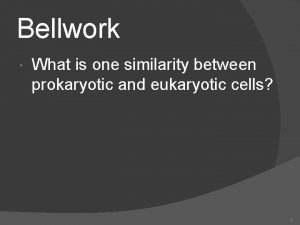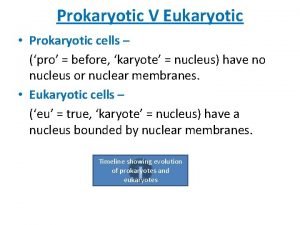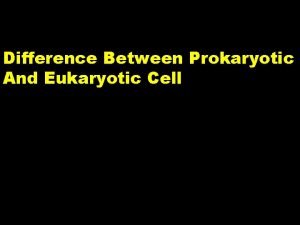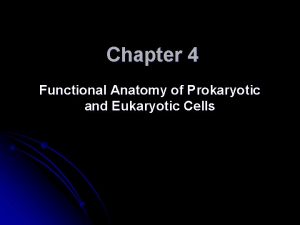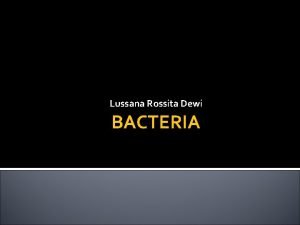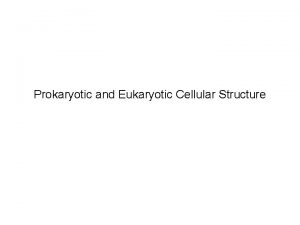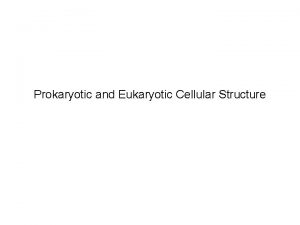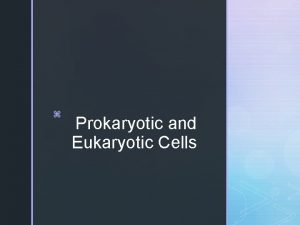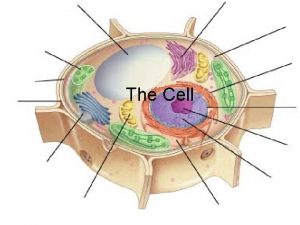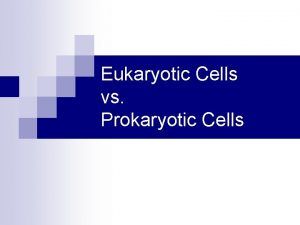Prokaryotic and Eukaryotic Cells Lussana Rossita Dewi In














- Slides: 14

Prokaryotic and Eukaryotic Cells Lussana Rossita Dewi

In general microbes or microorganisms may be either prokaryotic (bacteria) or eukaryotic (protists, fungi, and some animals). However, there are some microbial organisms that appear to be intermediates between prokaryotes and eukaryotes (they possess a nucleus but do not have mitochondria or chloroplasts, an example is Giardia intestinalis. Prokaryotes differ from eukaryotes in several ways including but not limited to:

Characteristics Prokaryotic Eukaryotic Types bacteria (monerans) protists, fungi, plants, and animals Organization unicellular usually multicellular (exception some protists) Cell size small (0. 1 -10 um) larger (10 -100 um) Membrane-bound absent present Reproduction asexual and sexual DNA circular linear organelles Proteins assoc. with DNA Basic Histone Plasma membrane No sterols Sterols Ribosomes 70 S 80 S Cytoskeleton Absent present

Eukaryotic Cell

Cell Membrane Cell membrane Structure Components Arrangement Functions include Barrier Transport (know diffusion, osmosis, facilitated diffusion and active transport) Recognition (e. g. , self vs. non-self) Reception (for protein hormones) Adhesion


Nucleus Structure and Function membrane similar to cell membrane (similar function) Nucleolus (formation of ribosomes) Chromosomes (gene expression) Nucleoplasm (matrix)

Ribosomes Structure r. RNA Proteins Function Site of protein formation (translation) Found in both prokaryotes and eukaryotes (different structurally)

Endoplasmic Reticulum • Structure membranous system of tunnels and sacs – Rough – with ribosomes on surface – Smooth- no ribosomes on surface • Function – Rough – protein synthesis – Smooth- lipid synthesis

Golgi Apparatus Structure also membranous, kind of like a stack of pancakes Function processing of lipids and proteins

Lysosomes Structure membrane bound sac containing hydrolytic enzymes Function digestion

Mitochondria Structure – cigar- shaped, double membrane-bound organelle Function – Energy transfer by ATP synthesis

Chloroplast Structure Also cigar or spindle shaped, double membranebound, green Function Site of photosynthesis

OTHER STUCTURES Cell walls, not in animal cells Vacoules Cytoskeleton Cytoplasm
 Prokaryotic versus eukaryotic
Prokaryotic versus eukaryotic Prokaryotic cells vs eukaryotic cells
Prokaryotic cells vs eukaryotic cells 4 types of eukaryotic cells
4 types of eukaryotic cells Is a red blood cell prokaryotic or eukaryotic
Is a red blood cell prokaryotic or eukaryotic What are three parts of the cell theory
What are three parts of the cell theory Diff between prokaryotes and eukaryotes
Diff between prokaryotes and eukaryotes Similarity between prokaryotic and eukaryotic cells
Similarity between prokaryotic and eukaryotic cells Comparison of prokaryotic and eukaryotic cells
Comparison of prokaryotic and eukaryotic cells Prokaryotic and eukaryotic cells chart
Prokaryotic and eukaryotic cells chart Pro karyote
Pro karyote Similarities between prokaryotic and eukaryotic cells
Similarities between prokaryotic and eukaryotic cells Differences between prokaryotic and eukaryotic cells
Differences between prokaryotic and eukaryotic cells Prokaryotic reproduction
Prokaryotic reproduction Anatomy of prokaryotes and eukaryotes
Anatomy of prokaryotes and eukaryotes Is eubacteria a true bacteria
Is eubacteria a true bacteria






